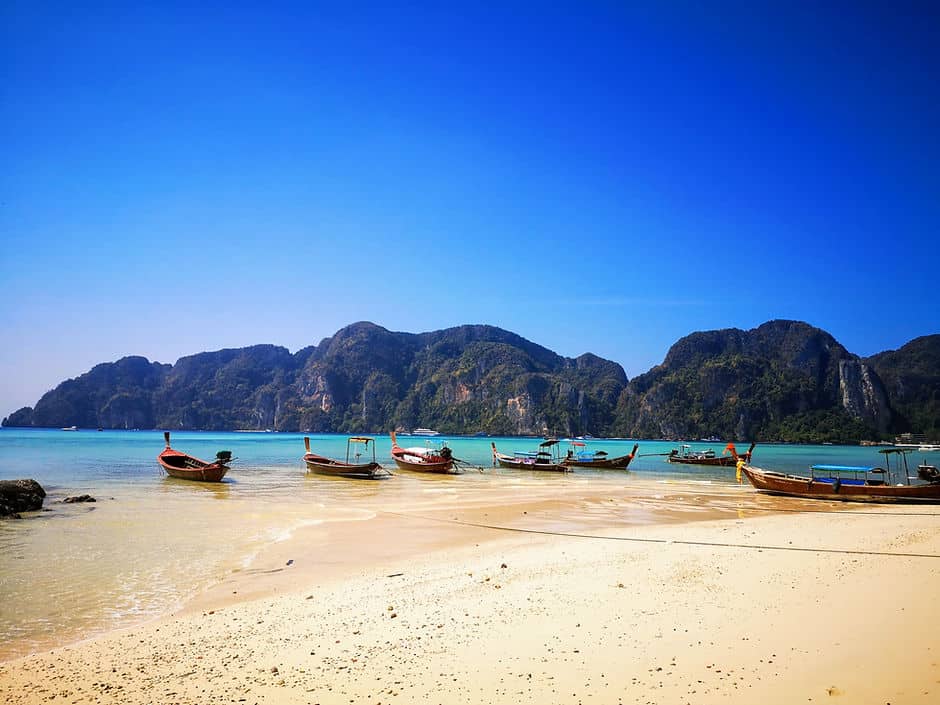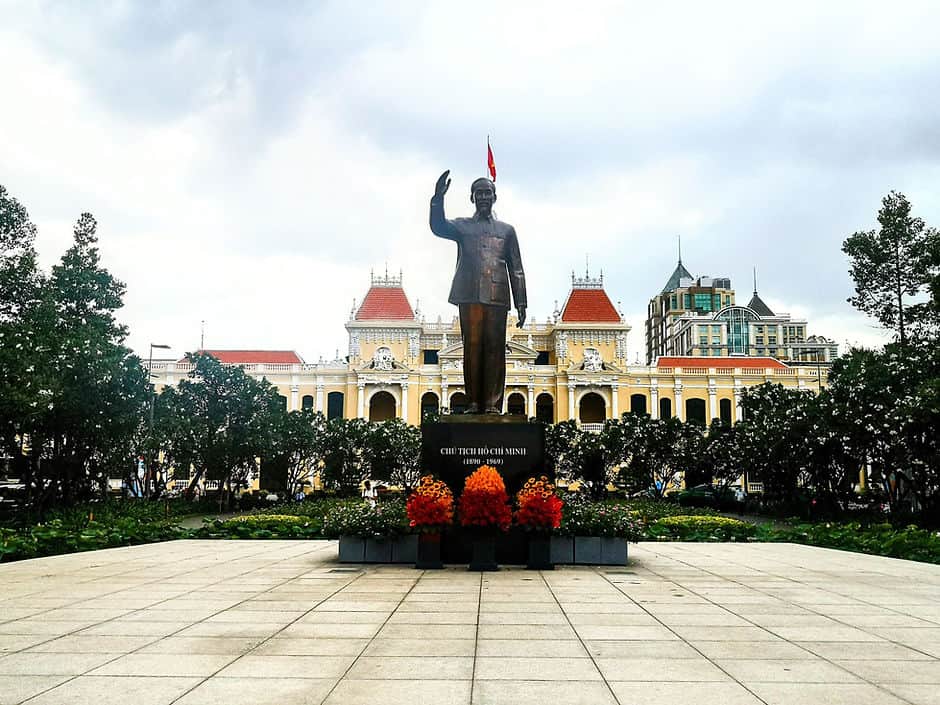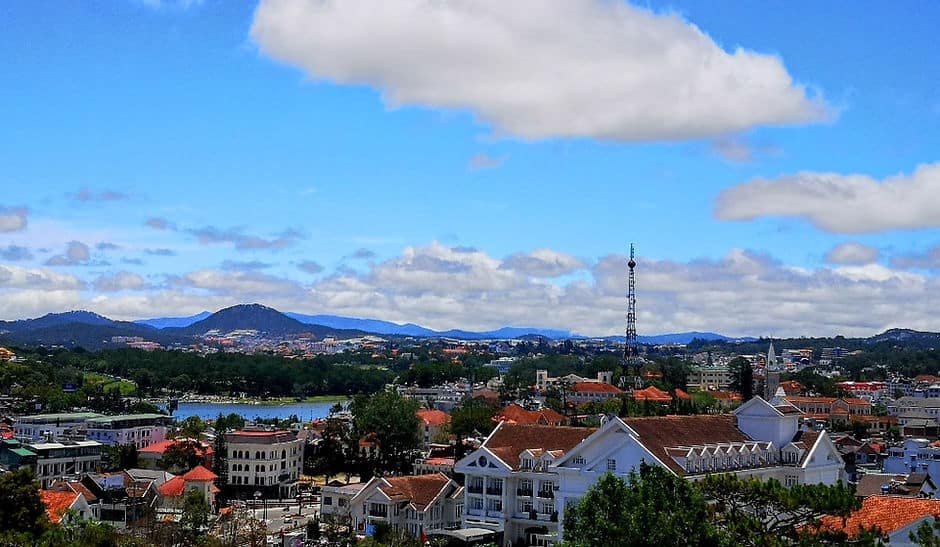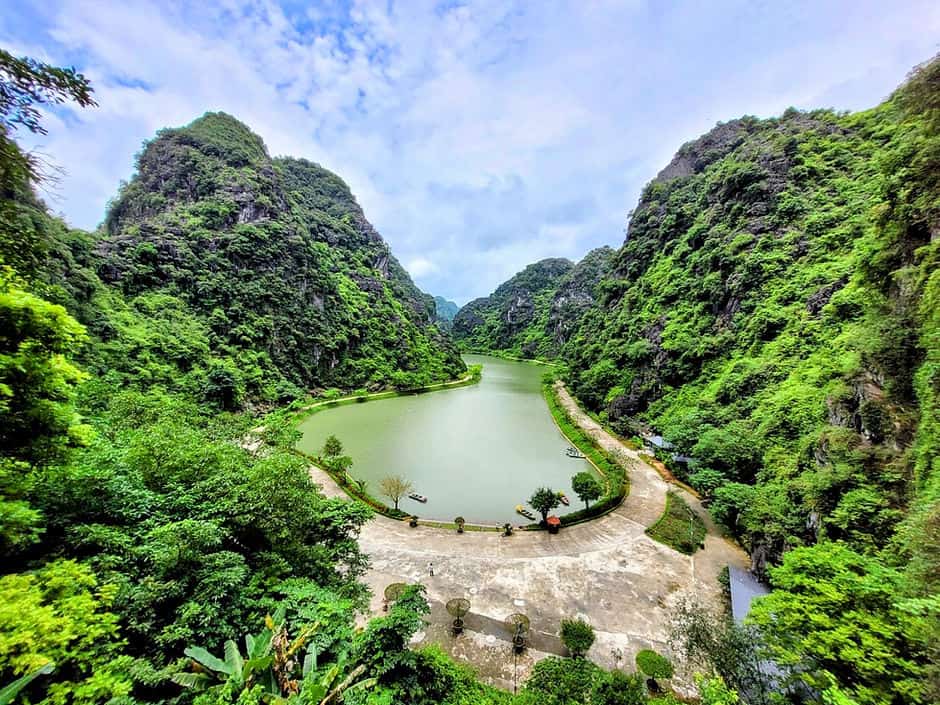
This post may contain affiliate links. I will receive a small commission if you use these links.
Planning a trip to Vietnam, but not sure where to start? This 1 month itinerary covers all the places my husband and I visited during our 4 week trip to Vietnam in May 2022. In this guide, I’ll share my Vietnam highlights, must-see places… and also the places I didn’t enjoy so much, along with recommendations and my top tips for travelling in Vietnam.
First time in Southeast Asia? Make sure you also check out my 50 essential travel tips for visiting Southeast Asia to help plan your trip!
Vietnam is a beautiful country in Southeast Asia, known for its stunning green landscapes, winding roads and bustling cities. It is a country of contrasts – with busy cities and sandy beaches in the south and rolling mountains in the north.
During our 4 weeks in Vietnam, we travelled from south to north, starting in Ho Chi Minh City and ending in Hanoi, but you can also do this route north to south. There are so many amazing places to add to your Vietnam bucket list!
Table of Contents
One month Vietnam Itinerary: Travel guides, tips and recommendations
Ho Chi Minh City: Days 1 - 3
Vietnam’s largest city, Ho Chi Minh City, is located in the south of the country. It’s a modern, vibrant city which is full of life – day and night. You’ll find all the things you might expect from a large city: big shopping malls, skyscrapers, fast food chains and rooftop cocktail bars. Despite the relatively new development in the city, there are still some traces of the traditional Vietnamese way of life, with local markets, street food stalls and small local restaurants and noodle shops tucked down little side roads.
Some of the best places to see in Ho Chi Minh City are located in the area around the Nguyen Hue Walking Street. This tree-lined pedestrianised promenade connects the Ho Chi Minh City Hall with the Saigon River. Strolling along Nguyen Walking street you can admire the architecture of the City Hall and the Opera House and see the statue of Ho Chi Minh himself.
There are plenty of restaurants and cafes on either side of the walking street, including the famous Cafe Apartments. The Cafe Apartments are a collection of businesses, shops and cafes housed in an old apartment block and are one of the best places to visit in Ho Chi Minh City. After you’ve taken a quick photo of the Cafe Apartment building from the outside, pay a visit to one of the cafes inside and grab a seat overlooking Nguyen Hue walking street – I can personally recommend Dosh for their shakes!
Another one of Ho Chi Minh City’s most visited places is the War Remnants Museum. The museum provides extensive information regarding the American-Vietnam war with 11 rooms of photographs, news articles and diary entries. There’s also a small exhibition detailing life in the war prisons and several planes and tanks on display outside of the building. This is quite a sobering visit but it is very informative and covers an important part of Vietnam’s history.
After you have visited the War Remnants Museum, take a daytrip to the Cu Chi Tunnels, located 2 hours outside of Ho Chi Minh City. A trip to the Cu Chi Tunnels is one of the most popular day trips from Ho Chi Minh City. Here, you can learn how the Vietnamese soldiers used the underground tunnel network in their battle against the American army in the war, and even experience what the tunnels are like for yourself.
Other great places to visit in Ho Chi Minh City include the Ben Thanh indoor market, where you can shop for clothes, shoes, souvenirs and local food produce and for nightlife in Ho Chi Minh, head to the lively Bui Vien walking street, with large nightclubs and bars.
Dalat: Days 4 - 6
Dalat is a mountain resort in the south of Vietnam, which is centred around the pretty Xuon Huong lake. The most popular way to travel from Ho Chi Minh City to Dalat is on the overnight sleeper bus. This can take between 7 and 9 hours, so expect to arrive in Dalat early in the morning. Dalat is a great place to stop to break up your journey between Ho Chi Minh City and the coast, and 2-3 days in Dalat will give you plenty of time to explore the main sights here.
One of the best things to do in Dalat is to visit The Crazy House. The Crazy House is a bizarre collection of buildings and spaces connected by undulating bridges and twisting walkways where nothing is normal. The cost of the Crazy House is only 60k vnd per person (£2) and is walking distance from the centre of Dalat, making it a great activity to do in the city. You can even stay overnight at the crazy house in one of the themed rooms!
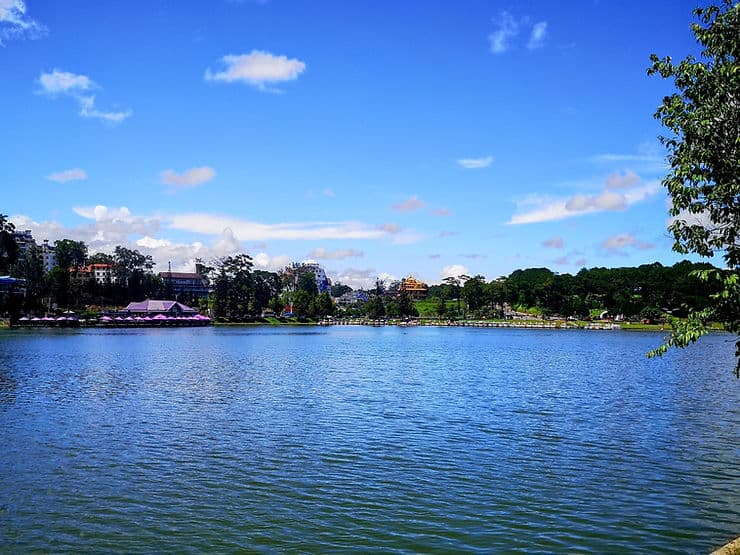
Another of Dalat’s most popular attractions is the Datanla Waterfall. The waterfall is quite commercialised and its popularity does mean that it can get busy, however it is a fun way to spend a couple of hours in Dalat. The best thing to do at Datanla Waterfall is to ride the Alpine coaster through the forest!
Located close to the Datanla waterfall, just outside of Dalat, is the Truc Lam Lake and Buddhist Monastery. Take a ride on the Dalat Cable Car between the Monastery and Dalat city for panoramic views over the forest hills and lake.
In the evening, go for a wander around Dalat night market. Although it’s not as good as some of the other night markets I’ve been to in Chiang Mai and Phuket in Thailand, there is a fun atmosphere here. As well as market stalls selling clothes and shoes, there’s live music, street food vendors and hotpot restaurants where you can cook your own BBQ meat and seafood.
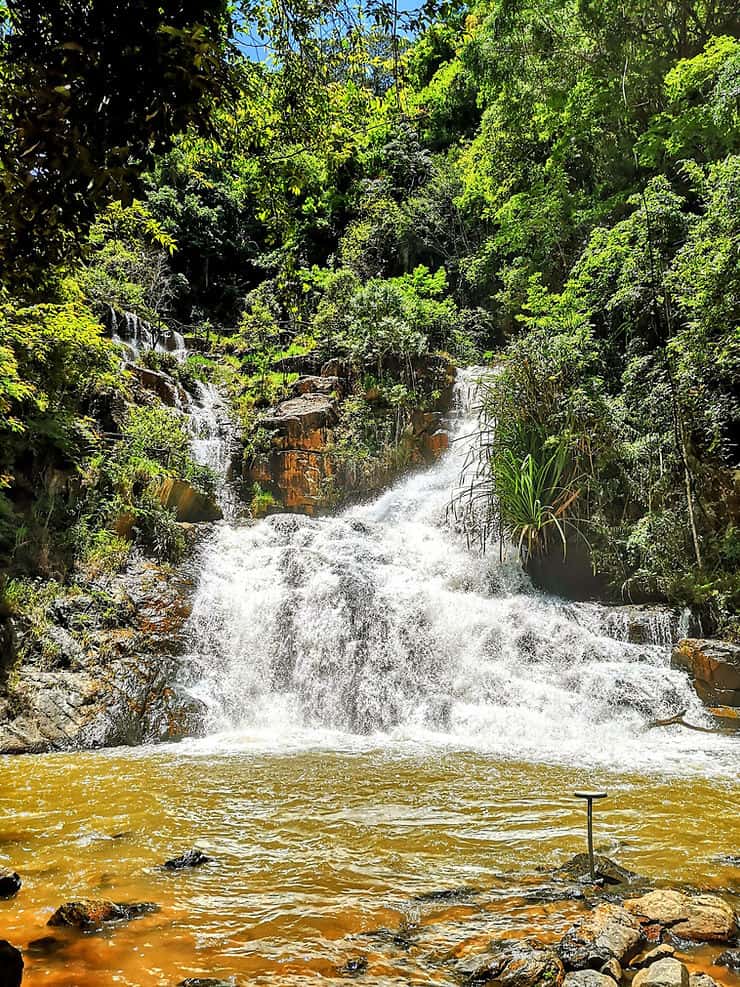
Nha Trang: Days 7 - 8
Nha Trang is a popular seaside resort in the south of Vietnam and is just a scenic 3 hour bus ride from Dalat. Initially we weren’t planning on stopping in Nha Trang, however, we decided that a couple of days relaxing on the beach sounded pretty nice.
Nha Trang is most famous for its long sandy beach, which stretches for almost 6km. Alongside the beach is a pedestrianised beachfront promenade with landscaped gardens, shady benches and drinks stalls. Overlooking the beach are tall skyscrapers and high rise hotels on a busy main road. Nha Trang is already a popular destination with local visitors, but it has received a great deal of recent development specifically aimed at bringing in more foreign tourists. There are modern shopping malls, fast food chains and lots of western restaurants and markets.
Although Nha Trang is quite popular, personally I wasn’t blown away by it. Perhaps this is because we visited in May 2022, when tourists had only just started to enter Vietnam again. The effect of the pandemic and lack of tourists over the previous 2 years was evident in Nha Trang and it felt a little lifeless to me. Also, the beach was not as pristine or clean as I had anticipated. So overall, I was left feeling a little disappointed. The silver lining for our stay in Nha Trang was the fact that we had a really nice hotel. We stayed in the Apus Hotel, which had a rooftop pool and small gym overlooking the sea and was a great place to relax and recharge for a couple of days.
If I was to take this trip again, I would definitely skip Nha Trang and head straight to Hoi An from Dalat. However, if you want to break up the journey, then Nha Trang is a good place to stop as you make your way up the coast. There are some nice hotels here if you just want to take it easy for a couple of days.
Hoi An: Days 9 - 12
Hoi An was one of my favourite places that we visited during our 4 weeks in Vietnam. From Nha Trang, we took the overnight sleeper bus and arrived in Hoi An at 5am. Hoi An is most well known for its historic unesco-heritage ancient town. Parts of the ancient town date back to the 15th century and it’s full of charm and character. Strolling through Hoi An’s ancient town amongst the old yellow buildings with traditional wooden shutters adorned with beautiful colourful lanterns is one of the best things to do in Hoi An.
Another great way to explore Hoi An is by bicycle and many of the hotels and guesthouses offer free bicycles for guests. Spend a few hours cycling out of the ancient town, into the more rural areas of Hoi An and to the beach. We stayed just outside the Ancient town at Onion homestay, which was fantastic and in a great location. One of the most popular activities in Hoi An is to take a ride on a coconut basket boat. The basket boat tour is very touristy but a lot of fun and a must-do when in Hoi An!
Hoi An is also a great place for shopping and there are many tailors in the town where you can get a tailor made outfit for a fraction of the cost back home! For one of the best things to do at night, visit the Hoi An night market and pick up some souvenirs or local street food before taking a ride on a rowing boat on the river.
Hoi An is one of the best places to visit in Vietnam, in my opinion, and is a great addition to any Vietnam itinerary!
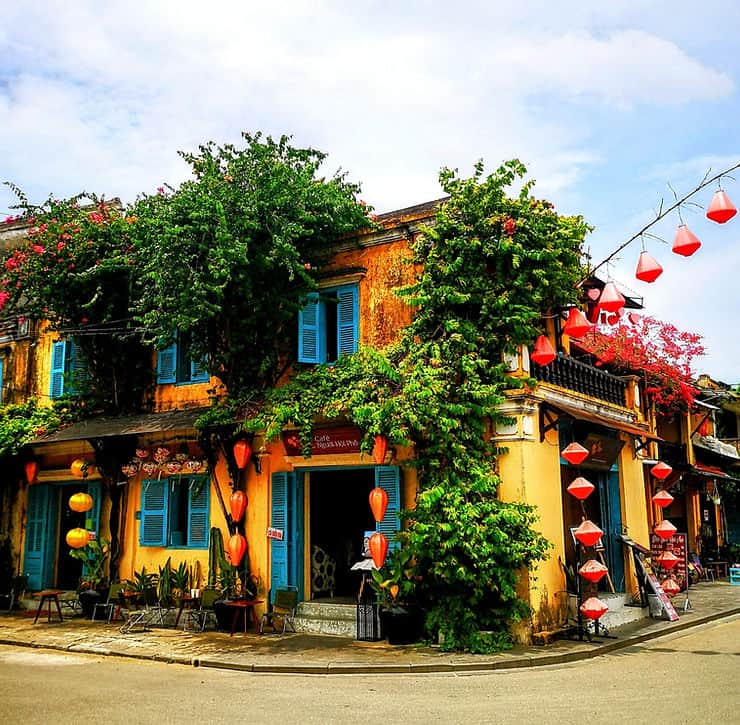
Hue: Days 13 - 15
Hue is just a short 3 hour bus journey from Hoi An and is known for its ancient Imperial City, which is the main reason we decided to visit Hue. The imperial city in Hue was built in the 1800’s and originally consisted of over 147 buildings. The city was an important site for the political and daily affairs of the Nguyên emperors who reigned between 1892 – 1945. Unfortunately the imperial City was heavily damaged during the American-Vietnam war, but parts of it have since been restored.
Entry for foreigners to the Royal Palaces of the Imperial City is 200k vnd (£7). To be honest I thought this was a little high compared to other sites we have been to in South East Asia. And I have to admit, after visiting the Grand Palace in Bangkok and the incredible Angkor Wat complex in Cambodia, I was a little underwhelmed by the imperial city in Hue. In addition to the Imperial City, there are several pagodas and tombs around Hue which you can visit either by taxi, hiring a scooter or joining a tour. Apart from visiting these and the Imperial City, there isn’t a lot else to do in Hue.
In hindsight, we would have been better going straight from Hoi An to Phong Nha as we didn’t really enjoy Hue too much.
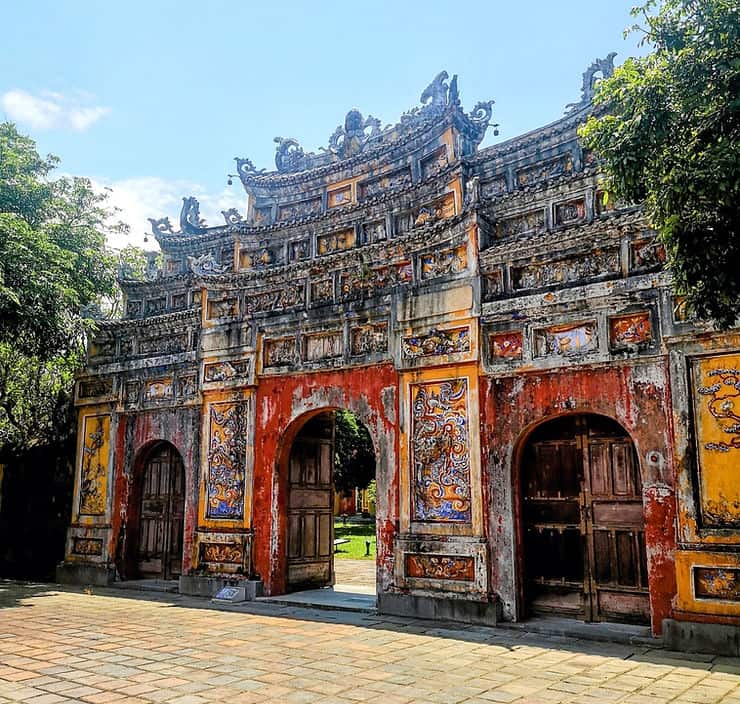
Phong Nha: Days 16 - 18
Phong Nha is a relatively new destination for tourists in Vietnam. Following the discovery of Son Doong – the world’s largest cave back in 2009, the Phong Nha-Ke Bang National Park has been slowly growing in popularity for thrill seekers and outdoor enthusiasts.
The town of Phong Nha is relatively small but there are several guesthouses and hostels as well as restaurants and convenience shops. The closer you stay to the main town centre, the more options you will have for places to eat. We stayed at Lucky Homes guesthouse which was really nice and we loved having our breakfast overlooking the river each morning.
Getting to Phong Nha can be tricky, especially if you’re on a budget, as there are fewer public transport options available. When we travelled in May 2022 most of the routes connecting Phong Nha with the larger towns were not back up and running yet. This meant that we had to get a bus from Hue to Dong Hoi, then take a 50 minute taxi ride to Phong Nha, which we arranged with our guesthouse. I would recommend contacting your accommodation to help you arrange transport to and from Phong Nha. They will be able to give you up-to-date information on which routes are running, rather than relying on internet booking sites.
Song Doong Cave
The main reason visitors go to Phong Nha is to visit the incredible collection of caves here. The most impressive cave in Phong Nha National Park is the Song Doong cave. It was originally discovered in 1991 but wasn’t properly explored until 2009 and was announced as the ‘world’s largest cave’. If you want to join an expedition into this cave, you will need to be an experienced climber and book far in advance. The expedition takes 4 days and costs around $3000 per person. But there are lots of other Phong Nha experiences you can book that are more budget friendly!
There are even some smaller caves which you can visit without a guide. During the two days we spent in Phong Nha, we visited Paradise cave and Phong Nha cave.
Paradise Cave
Paradise cave (known locally as Thien Duong cave) is one of the most popular caves in Phong Nha National Park. From Phong Nha town, you can either get a taxi or hire a scooter and drive there. From the entrance, it’s just a short 1km walk to the base of the cave or you can pay for a shuttle bus. When you reach the base of the cave, there are about 600 steps to reach the cave entrance. Paradise cave was only discovered in 2005 and is 31km long, making it the longest dry cave in Asia. You can walk 1km on the raised wooden boardwalks through the cave and it really is incredibly impressive.
Words and photos do not do this place justice, you just have to see it for yourself! I would highly recommend visiting this cave when you are in Phong Nha. If you want more of an adventure, you can pay for a guided tour which will take you another 4km into the cave with proper equipment.
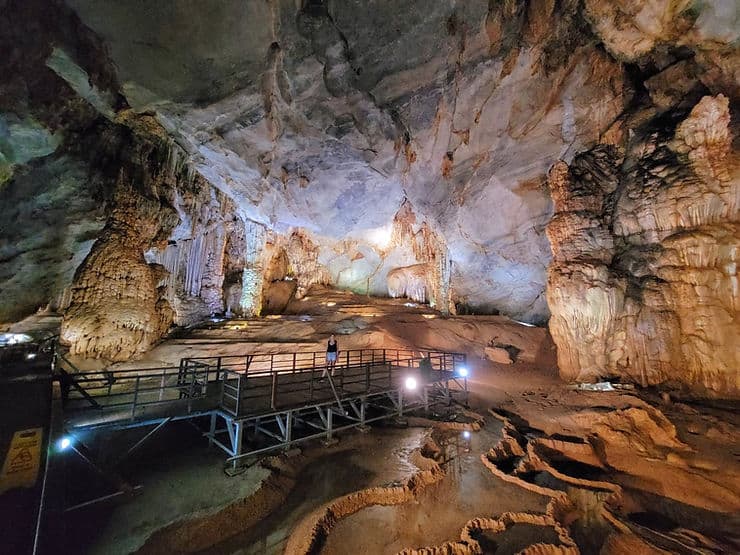
Dark Cave
Another popular cave in Phong Nha National Park is Dark Cave (known locally as Hang Toi). This cave is particularly great for those who want an adrenaline rush and a fun day out. You will need to join a guided tour to visit this cave as you’ll be zip-lining to the entrance of the cave as well as canyoning, wading through water and taking a mud bath!
Although the famous caves are the main reason people visit Phong Nha, there’s also several hiking trails around the National Park. As Phong Nha grows in popularity, now is a great time to visit and if you enjoy being outdoors, this is definitely one place you should add to your Vietnam itinerary.
Phong Nha Cave
Visiting Phong Nha cave requires you to take a boat ride so this is a great cave to visit if you don’t want to do much walking. Purchase your ticket from the office in the centre of town for 150k vnd (£5) and wait to be joined by other passengers. You will have a scenic boat ride down the river to the entrance of the cave. The boat will float gently into the cave for a short distance, before turning around. On your way out, there’s an option to jump off and walk about 500m through a small section of the cave, before getting back on the boat.
Ninh Binh province / Trang An / Tam Coc: Days 19 - 23
Following our time in Phong Nha, we got a taxi back to Dong Hoi where we caught another overnight bus to Ninh Binh and then a taxi to Trang An. Ninh Binh is in the north of Vietnam, and is both a city and province. If you’re thinking of travelling to Ninh Binh, don’t stay in the city, there’s nothing to see there, instead, you want to be in the region around Trang An and Tam Coc, which are located in the province of Ninh Binh.
Tam Coc is the main town in this area and you can find several convenience stores, larger hotels and hostels as well as bars, restaurants and salons. If you are looking for something quieter and more peaceful, stay in Trang An instead. We stayed at Trang An Memory homestay in a little chalet hut, nestled under the mountainside with views of the lake. The setting was idyllic! If you want something more central and lively, the Banana Tree hostel in Tam Coc is a popular choice.
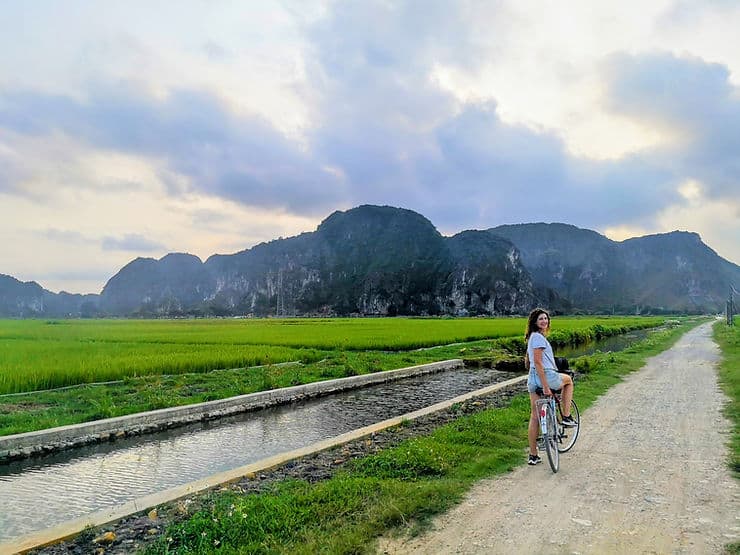
Ninh Binh province is often referred to as ‘Halong Bay on land’ due to the numerous limestone and karst mountains which are dotted all over the region. It really is a beautiful place to visit and this was one of my favourite places in Vietnam.
One of the best things to do in Ninh Binh is to take the Trang An scenic boat ride. You will float along the river on a small rowing boat through beautiful mountains, caves and lush green landscapes. Another great thing to do near Ninh Binh is to go to Hang Mua viewpoint. There’s a short climb up a series of steep steps to the top of the viewpoint. From there, you will get panoramic views across the rice fields, mountains and Trang An river.
Other sights in the area include Am Tien Lake, Hoa Lu Ancient capital and the Van Long nature reserve. Perhaps one of the best ways to explore Ninh Binh province is to hire a bicycle (or many of the home stays have them for free) and cycle around the countryside, taking in the views. This was definitely my favourite way to spend the day.
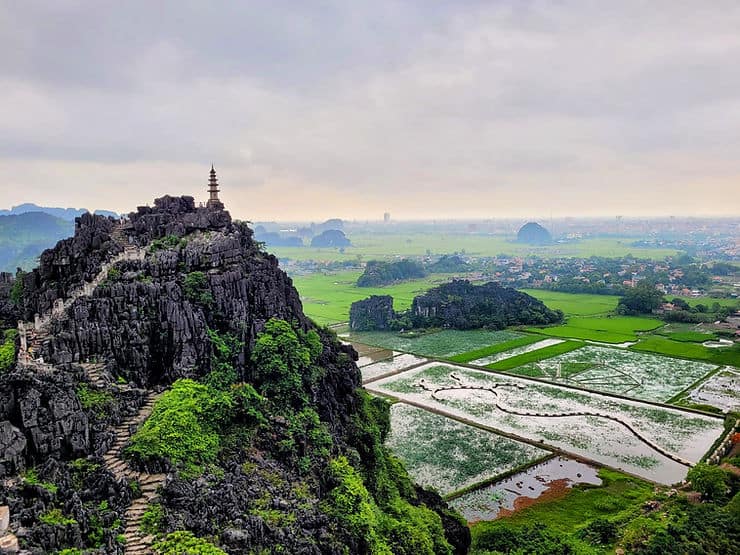
Hanoi (stopover before Halong Bay): Day 24
From Ninh Binh, it is a short 2 hour bus journey to Hanoi. We had just one night in Hanoi initially, ahead of our overnight trip to Halong Bay the following day.
Of course, if you wanted to go to Halong Bay, you could spend several days exploring Hanoi first, then go to Halong Bay at the end of your trip. At the time of our visit to Vietnam, there were only a limited number of operators running cruises to Halong Bay, so we had limited options in terms of days when we could join a trip that was still available.
Halong Bay: Days 25 - 26
Cruising in Halong Bay is one of the top ‘Bucket list’ activities for many people visiting Vietnam, including me. We chose a one night, two day overnight trip with Athena Cruise and had a great time. The tour included a bus transfer from and to Hanoi as well as all our meals on board the boat and several excursions.
During our two days on board we visited Sun Sot (Surprising cave) and Titov Island, where you can climb the viewpoint for some of the best views over Halong Bay. We also had the chance to kayak in Luon Cave and enjoyed relaxing on the sun deck. Watching the sunset and then rising again the next morning in the middle of Halong Bay was such a special moment. If you are considering a tour to Halong Bay, make sure that you research the itinerary as there are many companies who offer various tours with different excursions included. I’ve written a full review of our Halong Bay cruise here, so you can have a look at what to expect.
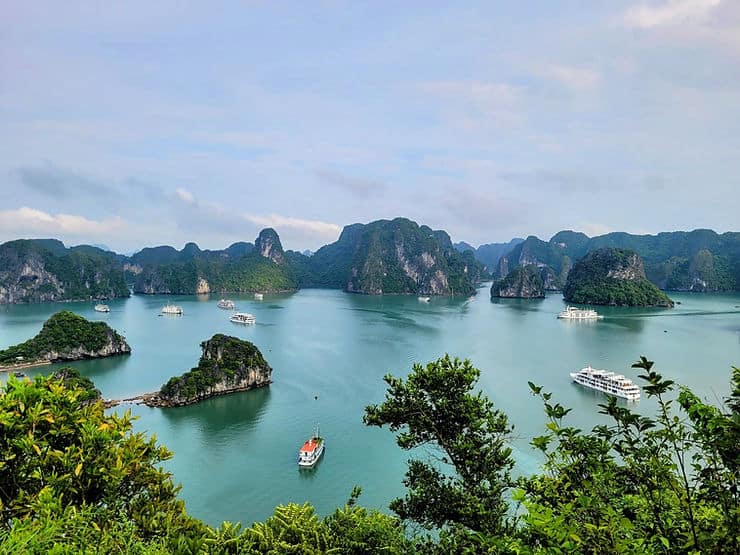
Hanoi: Days 27 - 30:
The capital of Vietnam, Hanoi is known for its historic architecture, bustling Old Quarter and the now-famous Hanoi Train Street. In stark contrast to the modern Ho Chi Minh City in the south, Hanoi is much more traditional. It’s a melting pot of Chinese, French and Southeast Asian influences and is quite charming.
One of the best things to do in Hanoi is to wander around the Old Quarter. Here, you’ll find a maze of narrow streets with local stores selling everything you could possibly want and need! Head over to Hanoi’s famous Train Street and pick a spot in one of the cosy cafes overlooking the train line and watch as the train passes by with only inches between you!
In the centre of Hanoi is Hoan Kiem Lake. There is a paved path all the way around the lake, perfect for exercising or a leisurely walk around. The Temple of Literature is another great place to visit in Hanoi. The small temple complex is centuries old and sits within beautiful landscaped gardens.
If you happen to be in Hanoi over the weekend, you’re in luck as the Hanoi Night Market takes place every week Friday – Sunday and is a great way to spend an evening in Hanoi. For some of the best nightlife in Hanoi, head to Beer Corner. There’s such a fun atmosphere here, with everyone sitting on small plastic chairs outside the bars enjoying the music with some drinks and street food.
Is there anything I would change about my Vietnam itinerary?
As the saying goes, hindsight is a wonderful thing and yes, there are definitely a few things I would change or recommend that you do differently.
As we only had one month in Vietnam, it was hard to fit everything in and unfortunately, this meant we didn’t get a chance to visit Sapa. This was a mistake. I’ve since spoken to fellow travellers who visited Sapa and they loved it and the photos from there really do look beautiful. If I could change anything it would be to remove Nha Trang and Hue from this itinerary and instead, use the extra days to visit Sapa at the end of the trip. The only other thing I wished I could have done differently was to have spent more time here! I loved Vietnam, it really is a great country to travel in and the landscapes are just beautiful.
Useful information for travelling in Vietnam
When is the best time to visit Vietnam?
The climate in Vietnam varies depending on where you are in the country, as the seasons in the north and south vary slightly. But overall, the best time to visit is between January and May. The worst time to visit Vietnam is between August – October when the country experiences its highest rainfall.
How to get to Vietnam?
By plane: Vietnam has three international airports in Ho Chi Minh City, Da Nang and Hanoi. Flying into Vietnam is straightforward and can be easier than crossing a land border, but it is the more expensive option. If you are travelling the length of the country, it is best to fly into either Ho Chi Minh City and work your way up to Hanoi, or fly into Hanoi and work your way down. This means that you would be flying in and out of a different airport, so book two one-way tickets, unless your airline allows you to book a multi-city ticket.
By land: Vietnam has several land borders with Cambodia, Laos and China. There are buses that run between Cambodia and Laos with Vietnam and from China there is a train into Hanoi. At the time of my visit in May 2022, I was travelling to Vietnam from Cambodia and the land borders had only just reopened. Unfortunately not all of the large bus companies were operating routes across the border between these two countries. However, I did manage to find a small, local company via a Vietnam travel group on Facebook who offered a shared minibus to get across the Moc Bai border. As of December 2022, I understand that more companies are now operating on this route again.
Moc Bai is one of the busiest land border crossings between Cambodia and Vietnam, travelling between Phnom Penh in Cambodia and Ho Chi Minh City in Vietnam. If you are travelling via land border, make sure that you have all your paperwork prepared and watch out for scams – they are more frequent at the land borders sadly.
Do I need a visa to travel to Vietnam?
Most nationalities will need a visa in order to visit Vietnam. Currently, tourists can only apply for a 30 day visa, and unlike previously, this cannot be extended in the country. If you want to stay in Vietnam for longer than 30 days, you will need to leave the country and re-enter on a new 30 day visa.
How to get around Vietnam?
Travelling in Vietnam is relatively easy. For getting around in the towns and cities, taxis and motorbike taxis are readily available, and in the larger cities public buses are also a great way to get around cheaply. If you are travelling a longer distance between places, there are many overnight sleeper buses – this is definitely the best way to travel long distances in Vietnam, especially if you are on a budget. The buses can be booked via sites like 12go, or ask your hotel or hostel to help you book one. One thing to note when booking the overnight sleeper buses is that they often arrive much earlier than scheduled, which means you might be left outside at 5am waiting to check into your hotel or hostel! If budget is not an issue, then the best and fastest way to travel long distances is to fly.
What currency does Vietnam use?
The currency of Vietnam is Vietnamese Dong (vnd). It helps to arrive in the country with some ‘dong’ as you will need this to pay for taxis or buses on arrival. There are places where you can exchange money, however we found that they were in tourist offices or jewellery shops, rather than designated currency exchange offices, even in larger cities like Ho Chi Minh. Always check with your hotel or hostel which exchange places are reputable to avoid getting ripped off.
There are plenty of ATM’s in the larger towns and cities, so you can withdraw dong, however be aware that many of the cash machines will charge, even if your bank doesn’t. I travel with a Starling bank card, which is great for avoiding bank charges abroad. Also, always remember to select ‘transaction without conversion’ at the ATM to avoid high exchange rates on your withdrawal.

